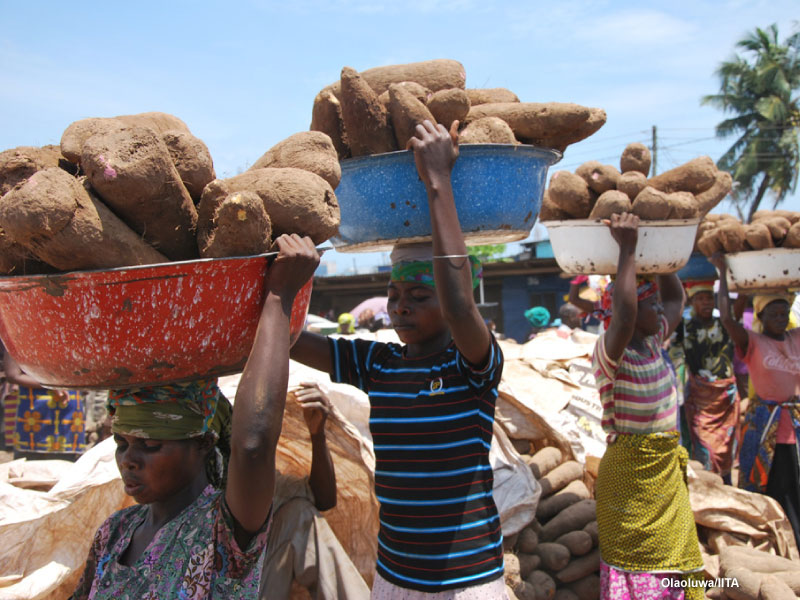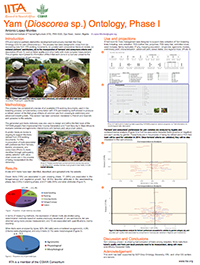Participatory varietal selection meets yam farmers’ needs
 Yam is an important source of food and income in Ghana and Nigeria, which is why RTB is supporting an accelerated breeding pipeline for yam improvement in those countries. In order to ensure that the varieties coming out of that pipeline meet the needs of farmers, and thereby improve the probability that smallholders adopt them, researchers at IITA helped breeders at national programs in Ghana and Nigeria to design and implement a participatory varietal selection (PVS) methodology for yam. That methodology, which puts farmers in charge of field trials and the selection of the varieties best suited for local preferences and environmental conditions, resulted in the selection of the five best new varieties for each of three different agroecologies.
Yam is an important source of food and income in Ghana and Nigeria, which is why RTB is supporting an accelerated breeding pipeline for yam improvement in those countries. In order to ensure that the varieties coming out of that pipeline meet the needs of farmers, and thereby improve the probability that smallholders adopt them, researchers at IITA helped breeders at national programs in Ghana and Nigeria to design and implement a participatory varietal selection (PVS) methodology for yam. That methodology, which puts farmers in charge of field trials and the selection of the varieties best suited for local preferences and environmental conditions, resulted in the selection of the five best new varieties for each of three different agroecologies.
IITA yam breeder Antonio Lopez-Montes, who led the PVS initiative, explained that breeders at the national programs didn’t pay enough attention to farmer-preferred traits in the past, and largely ignored women’s preferences. IITA researchers consequently worked with 23 yam breeders and technicians at the National Root Crops Research Institute in Nigeria, and the Crops Research Institute and Savanna Agriculture Research Institute in Ghana, to adapt and implement a gender-responsive PVS for yam.
The three institutes partnered with thousands of farmers who ran field trials for 24 yam varieties developed by IITA and participated in evaluations that resulted in the selection of the top five varieties recommended for release in Northern Ghana, Central Ghana and Nigeria. The initiative took place within the framework of the ‘Yam Improvement for Income and Food Security in West Africa’ project, funded by the Bill & Melinda Gates Foundation.
A total of 4,328 farmers in the two countries participated, including 1,323 women. Lopez-Montes explained that they made an effort to involve as many women as possible so that selected varieties would meet the needs of both women and men, in order to ensure greater adoption. He added that farmers were involved in the design of field trials – deciding issues such as plant density and fertilizer application – which they ran. Farmers evaluated the varieties at the bulking and harvest stages, when researchers from the national institutes recorded the criteria of individuals and groups.
The farmers also contributed to the design of agronomic packages for different production systems that were scaled out for validation with the selected varieties in 2016. Lopez-Montes noted that the farmer-led focus on production systems, rather than agroecologies, is important because the performance of varieties can vary significantly from one production system to the next.
While all varieties were bred for drought-prone environments and poor soils, the farmer evaluations included traits such as flavor and the number and size of tubers produced by each plant. Evaluation data were disaggregated according to gender and age group.
Lopez-Montes observed that while men were more interested in varieties that produce one large tuber, which demands a high market price, women preferred varieties that produce multiple tubers of different sizes, in order to sell the big ones but save the smaller ones for family consumption and seed. He added that IITA breeders have already developed new populations of improved yams with traits preferred by women that are ready to be delivered to the three institutes, and they will continue to develop populations with combinations of the traits preferred by women and men. This should enhance adoption and improve household food security, as women pay more attention to the full spectrum of family needs.
To complement farmer criteria, breeders collected and analyzed quantitative data on traits such as dry matter content, the number of ware and seed yam per plant, and the incidence and severity of pests and diseases. However, Lopez-Montes noted that farmer criteria were the drivers of the selection process and that the quantitative data supported the farmers’ selections.
“We implemented this project to demonstrate the advantages of using PVS to increase a new variety’s impact,” Lopez-Montes said. “The national breeders recognized that this approach can ensure greater adoption, because the farmers already accepted these varieties during the selection process.”
Related links

